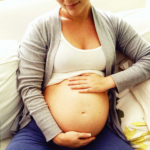Most studies evaluating the prevalence of perinatal depression are cross-sectional, meaning that depressive symptoms are measured at a single point in time. Less information is available regarding the trajectory of perinatal depression. In obstetric populations, it seems that there are women with briefer episodes of milder postpartum depressive symptoms, while others have more persistent and debilitating depressive symptoms after childbirth. Other women experience depression during pregnancy. Several studies suggest that there is considerable heterogeneity among women who experience depressive symptoms during pregnancy and the postpartum period.
In a recent prospective, longitudinal study from the University of Bordeaux, a sample of 579 women attending antenatal and postpartum clinics were assessed from 8 months of gestation to 2 years using the CES-D. These women were described as being at low risk for perinatal depression (most having no past personal history of self-reported depressive episodes), and the researchers excluded women with histories of chronic severe mental illness, women with multiple pregnancies, and women who had become pregnant through in vitro fertilization.
In this population, the researchers found four distinct trajectories of postpartum depressive symptoms.
- 72% of the women never presented with clinically significant depressive symptoms;
- 4% presented with depressive symptoms only during the postpartum period;
- 21% presented with depressive symptoms throughout the two year follow-up period, with a higher intensity of symptoms during pregnancy;
- 3% presented with stable highly intense symptoms throughout the follow-up period.
In this low-risk population, what we see is that the vast majority of women who have postpartum symptoms also have symptoms during pregnancy. This would indicate that what is typically called postpartum depression in many women is actually the persistence of depressive symptoms which emerge for the first time during pregnancy. Because the women entered into the study during the 8th month of gestation, we don’t know when the depressive symptoms first emerged.
A similar prospective observational from Mora et al (2009) included 1735 low-income, inner-city women at high risk for PPD (defined as being younger, being low-income and mainly having a high school or lower educational level). Women were assessed prenatally (mean gestational age 15.1 weeks) and three times postpartum (3, 11 and 25 months) using the CES-D.
This study also found different trajectories of perinatal depressive symptoms.
- 71% were never depressed during the assessment period;
- 6% of the women were depressed only during pregnancy;
- 9% of the women were mildly depressed during pregnancy with higher levels of depressive symptoms at 4 months postpartum and recovery around 18 months postpartum;
- 14% of the women remained depressed at one year postpartum;
- 7% of the women were depressed throughout the duration of the evaluation period
Although more and more we hear about screening for mood disorders during pregnancy, most screening for depression takes place after delivery. These studies call into question the ideal timing for depression screening. If we wait until after the baby is born, we may be missing an opportunity to initiate interventions which may decrease the risk of postpartum depression and which may help to minimize the effects of maternal depression on the family.
Also of concern is that both studies observe high percentages of women with chronic or persistent depressive symptoms observed up to two years after childbirth. In the first study of low-risk women, 24% of the women experienced depressive symptoms throughout the two year period of follow-up. In the other study, 14% of the women were still depressed at one year postpartum and 7% of the women were depressed throughout the entire period (from pregnancy up to two years postpartum). Given the negative impact of maternal depressive symptoms on the child’s well-being and development, this high prevalence of persistent (presumably untreated) depressive symptoms constitutes a significant public health issue.
While the two studies differ somewhat in their findings, both studies indicate that perinatal depression cannot be considered as a homogenous entity. It appears that several different patterns of perinatal depressive symptoms exist, with a significant number of women presenting with more persistent depressive symptoms. These studies also call into question the consideration of postpartum depression as a distinct entity, as many of the women with postpartum depressive symptoms already experience depressive symptoms during pregnancy. Further studies are necessary to better delineate these different subtypes of perinatal depression.
Ruta Nonacs, MD PhD
Mora PA, Bennett IM, Elo IT, Mathew L, Coyne JC, Culhane JF. Distinct trajectories of perinatal depressive symptomatology: evidence from growth mixture modeling. Am J Epidemiol. 2009 Jan 1;169(1):24-32.
Sutter-Dallay AL, Cosnefroy O, Glatigny-Dallay E, Verdoux H, Rascle N. Evolution of perinatal depressive symptoms from pregnancy to two years postpartum in a low-risk sample: the MATQUID cohort. J Affect Disord. 2012 Jun;139(1):23-9.







As someone who has worked as a perinatal psychiatrist for over 20 years now it has always intrigued me that so much reserach tries to address the question of perinatal depression as if it is a single disorder, not heterogenous. This latest research is perhaps getting closer to clinical reality, acknowledging this diversity : from those who have been depressed prior to pregnancy and it being a recurrence in pregnancy, to those where it emerges in pregancy ( whether due to hormones or the physical demands of pregnancy or unwantedness of pregnancy or relationship issues triggered by the pregnancy including increased levels of male violence and infidelity at the extreme end, etc,) to those where it emerges afterwards due to the stress of birth ( may be an element of acute post traumatic stress or shock) to those with adjustment issues , control issues, obsessive anxiety etc etc, to those where it comes on later maybe due to exhaustion and sleep deprivation , or the shock of mundane reality. to the conflict of maybe having to return to work, to isolation, etc etc etc. Post Natal Depression is such a usefull label, but it is not a “thing” in itself mostly and maybe we need to teach this more.